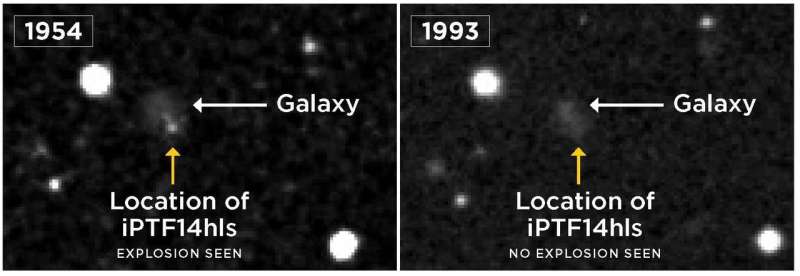There you go, making excuses for Tesla, see, I told you he would fit right in today.
- ...
- 552 posts total
Star exploded, survived, and exploded again more than 50 years laterby Carnegie Institution for Science 
It’s the celestial equivalent of a horror movie villain—a star that wouldn’t stay dead. An international team of astronomers including Carnegie’s Nick Konidaris and Benjamin Shappee discovered a star that exploded multiple times over a period of 50 years. The finding, published by Nature, completely confounds existing knowledge of a star’s end of life, and Konidaris’ instrument-construction played a crucial role in analyzing the phenomenon. In September 2014, the intermediate Palomar Transient Factory team of astronomers detected a new explosion in the sky, iPTF14hls. The light given off by the event was analyzed in order to understand the speed and chemical composition of the material ejected in the explosion. This analysis indicated that the explosion was what’s called a type II-P supernova, and everything about the discovery seemed normal. Until, that is, a few months later when the supernova started getting brighter again. Type II-P supernovae usually remain bright for about 100 days. But iPTF14hls remained bright for more than 600! What’s more, archival data revealed a 1954 explosion in the exact same location. 
It turned out that somehow this star exploded more than half a century ago, survived, and exploded again in 2014. "This supernova breaks everything we thought we knew about how they work," said lead author Iair Arcavi of University of California Santa Barbara and Las Cumbres Observatory. An instrument built by Konidaris was key to analyzing the light emitted by iPTF14hls, which dimmed and brightened at least five times over three years. Called the SED Machine, Konidaris’ tool is able to rapidly classify supernovae and other short-lived astronomical events. A quick turnaround on classifying these kinds of so-called transient objects in the sky was sorely needed when Konidaris and former colleagues at Caltech first built the machine. 
Stellar explosions teach astronomers a great deal about the origins of much of the material that makes up our universe. A supernova explosion may even have triggered the formation of our own Solar System. "But not too long ago it was faster to identify short-lived celestial phenomena than it was to classify them and determine what they could teach us," Konidaris said. "Which is why we built SED, but I never expected it would help us analyze an explosion as strange as this zombie star." "Nick’s role in this discovery demonstrates the importance of having an active instrumentation effort, which is increasingly rare on many campuses," added Observatories Director John Mulchaey.
@kitechaser, same article I linked previously |
@kitechaser the most unexplainable part of the whole observation is as follows:
|
When scientists come across unexplainable they look for answers. I wonder has science stood still since 2017? Toss up their hands and give up? Very curious, could there be more about iPTF14hls, have other astrophysicists been studying this mystery? Maybe science stood still and wrote this up to electric universe "theory", is that term even applicable ? |
@djones51 A supernova like this cannot exist, according to mainstream theories about star formation. This is akin to having an apple falling from a tree reliably and predictably, and then One day instead of falling...it zips straight into outer space, over and over and over and over again. The underlying "Theory" of star formation has to be reexamined, is that being done?? You tell me. |
- 552 posts total

